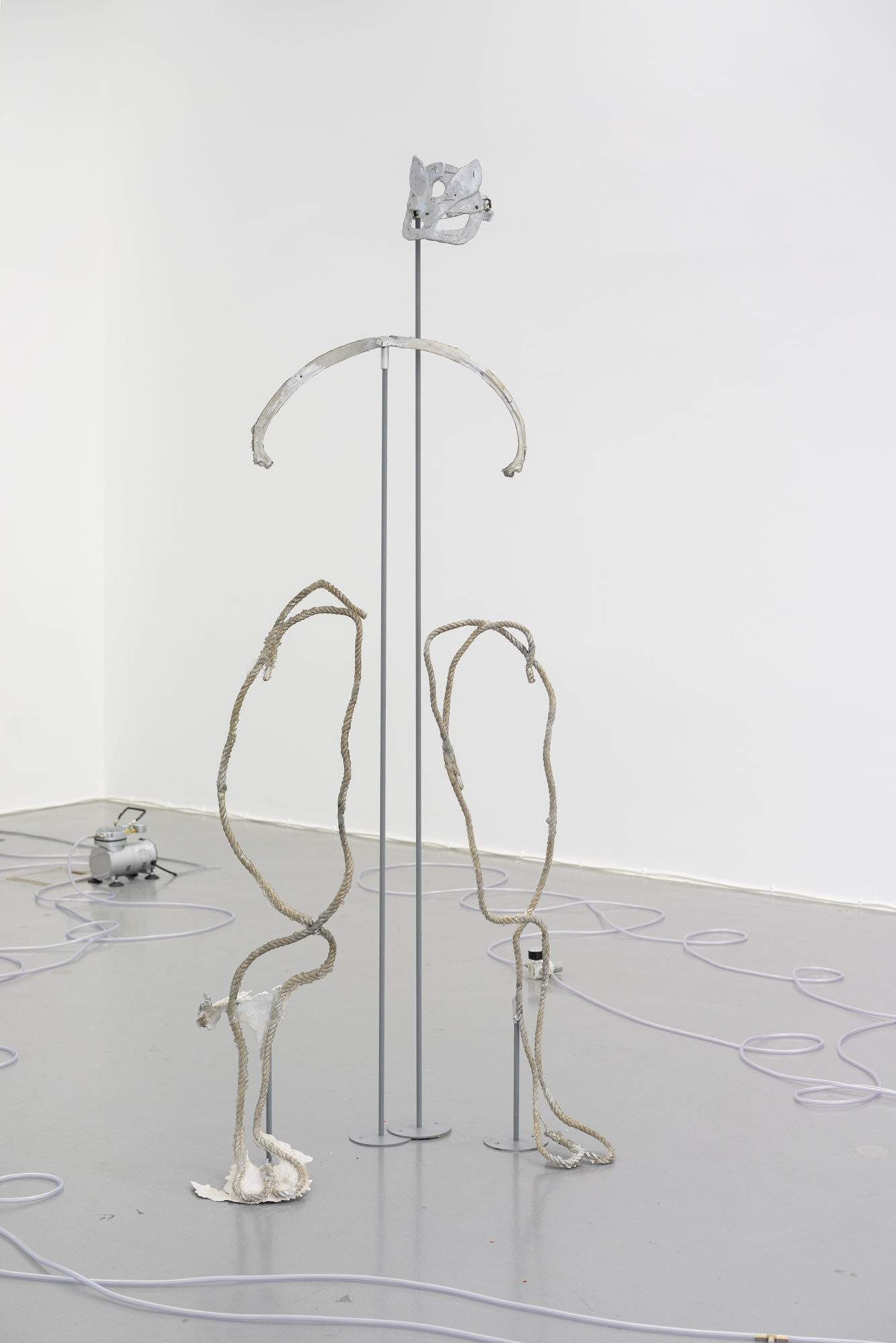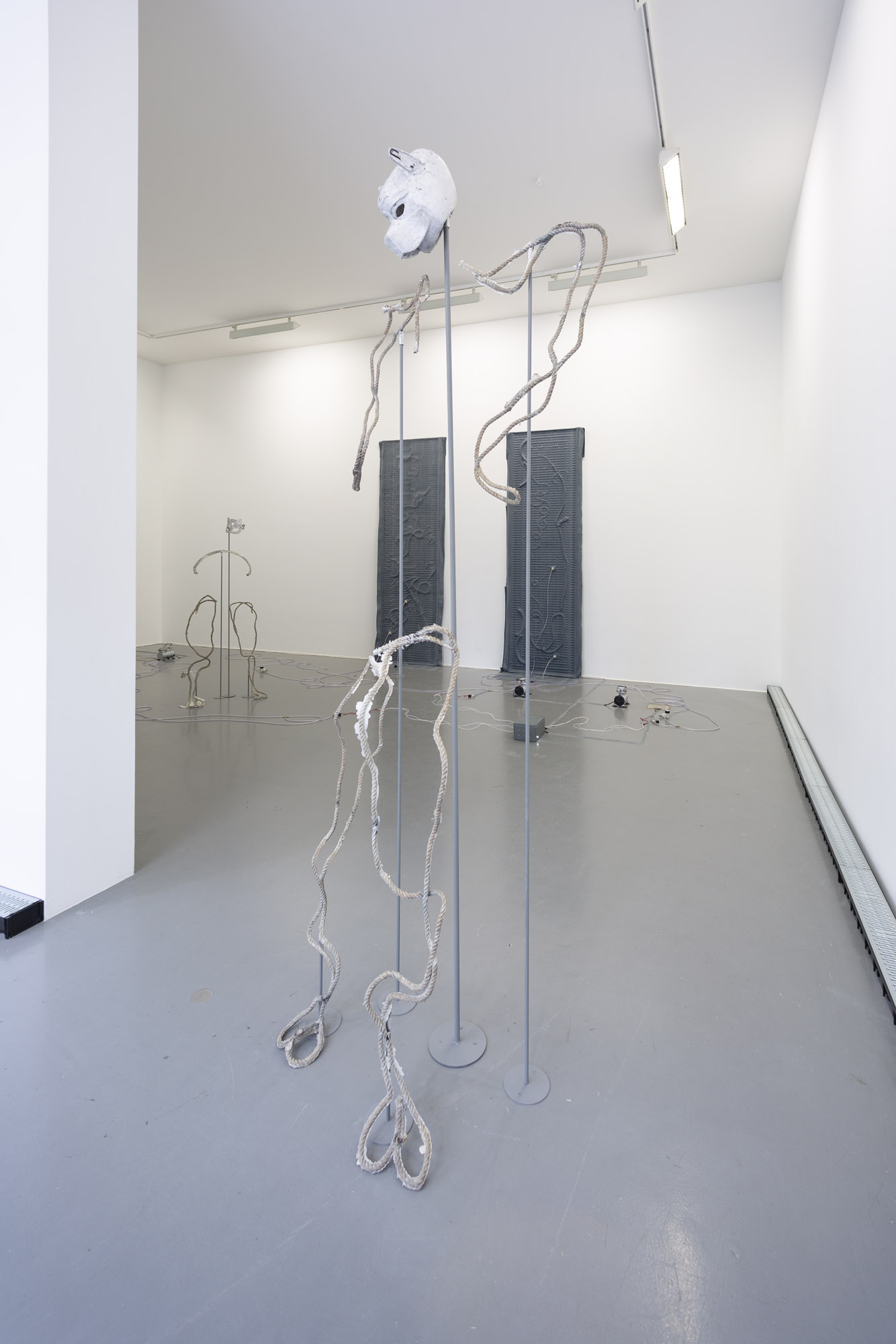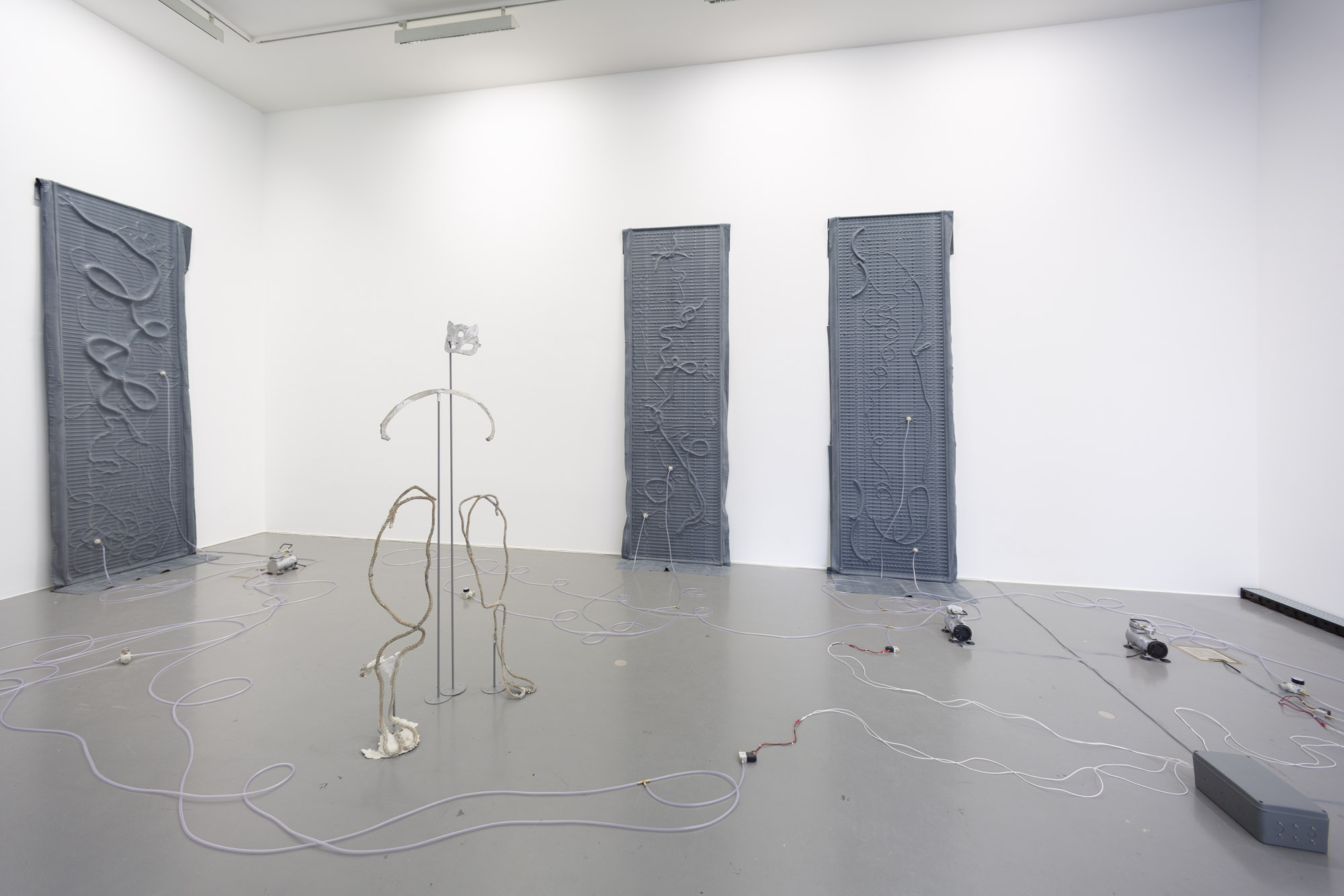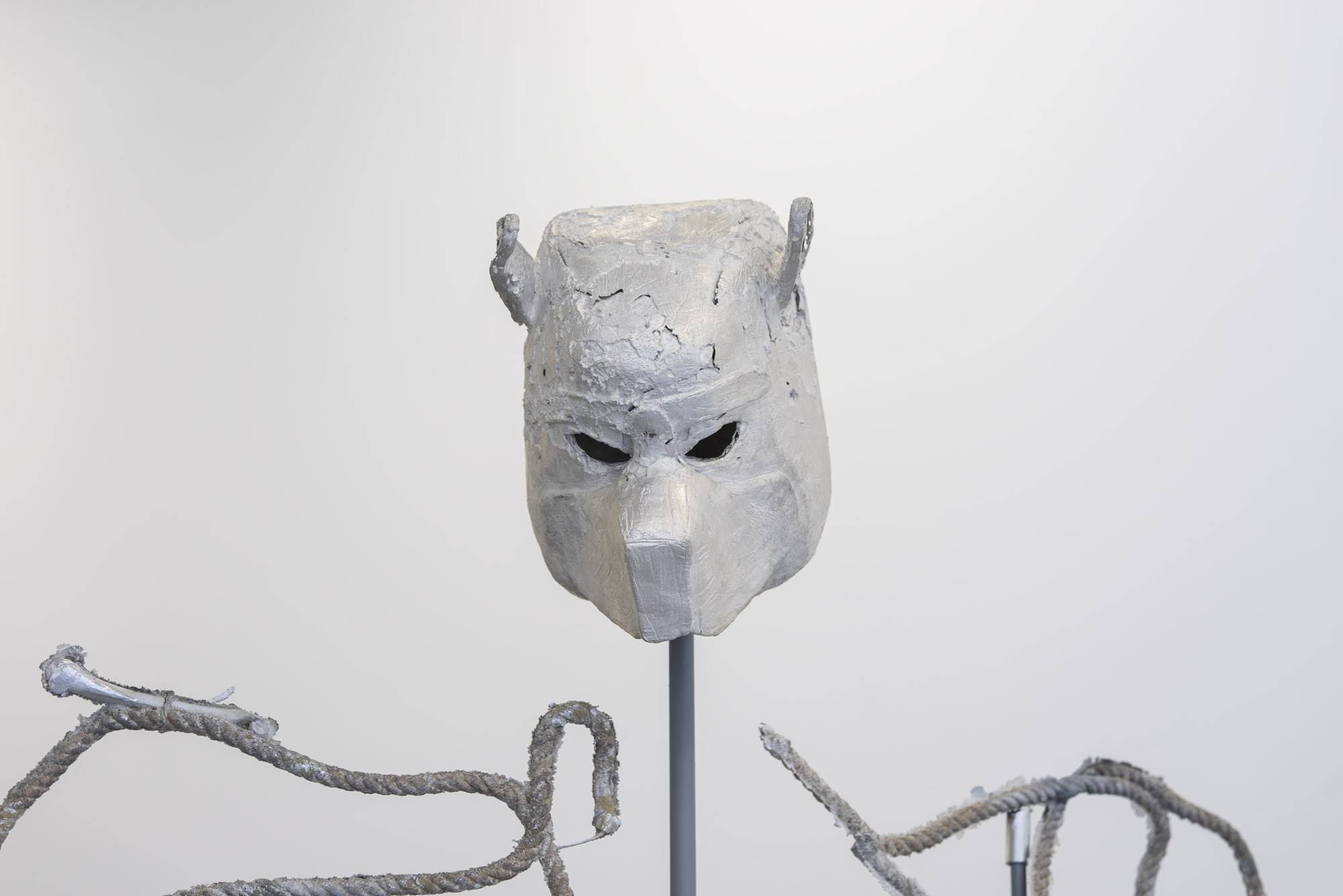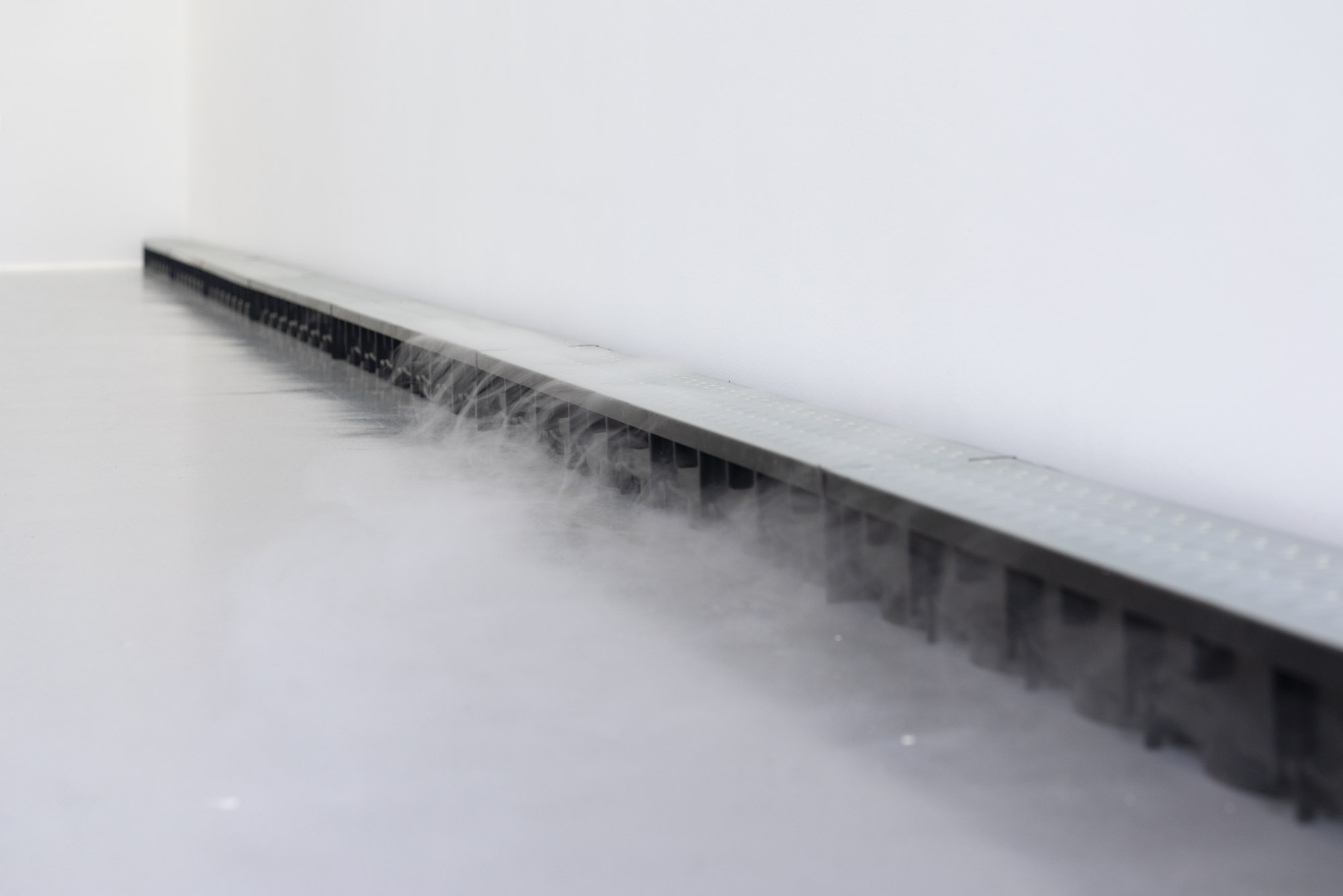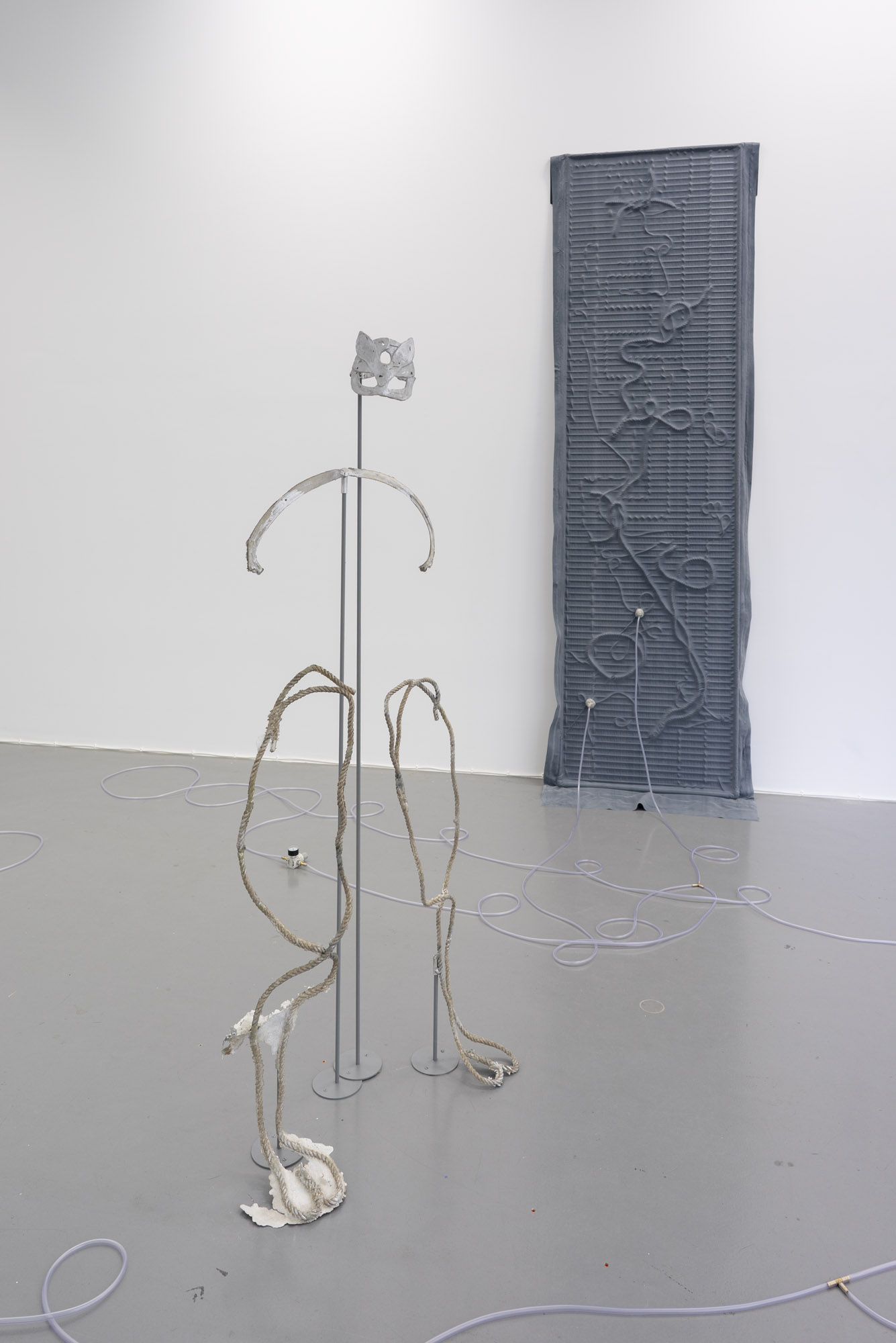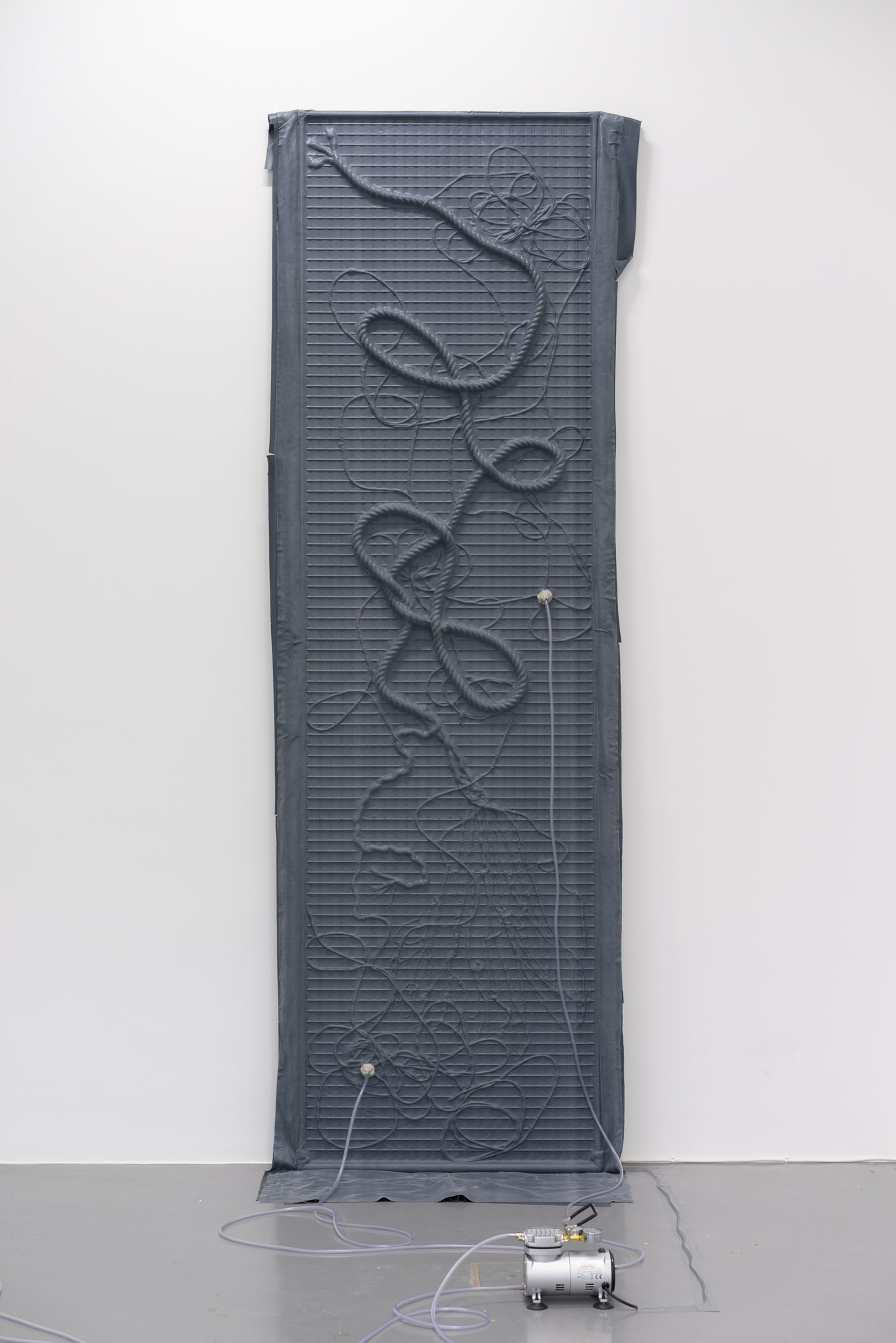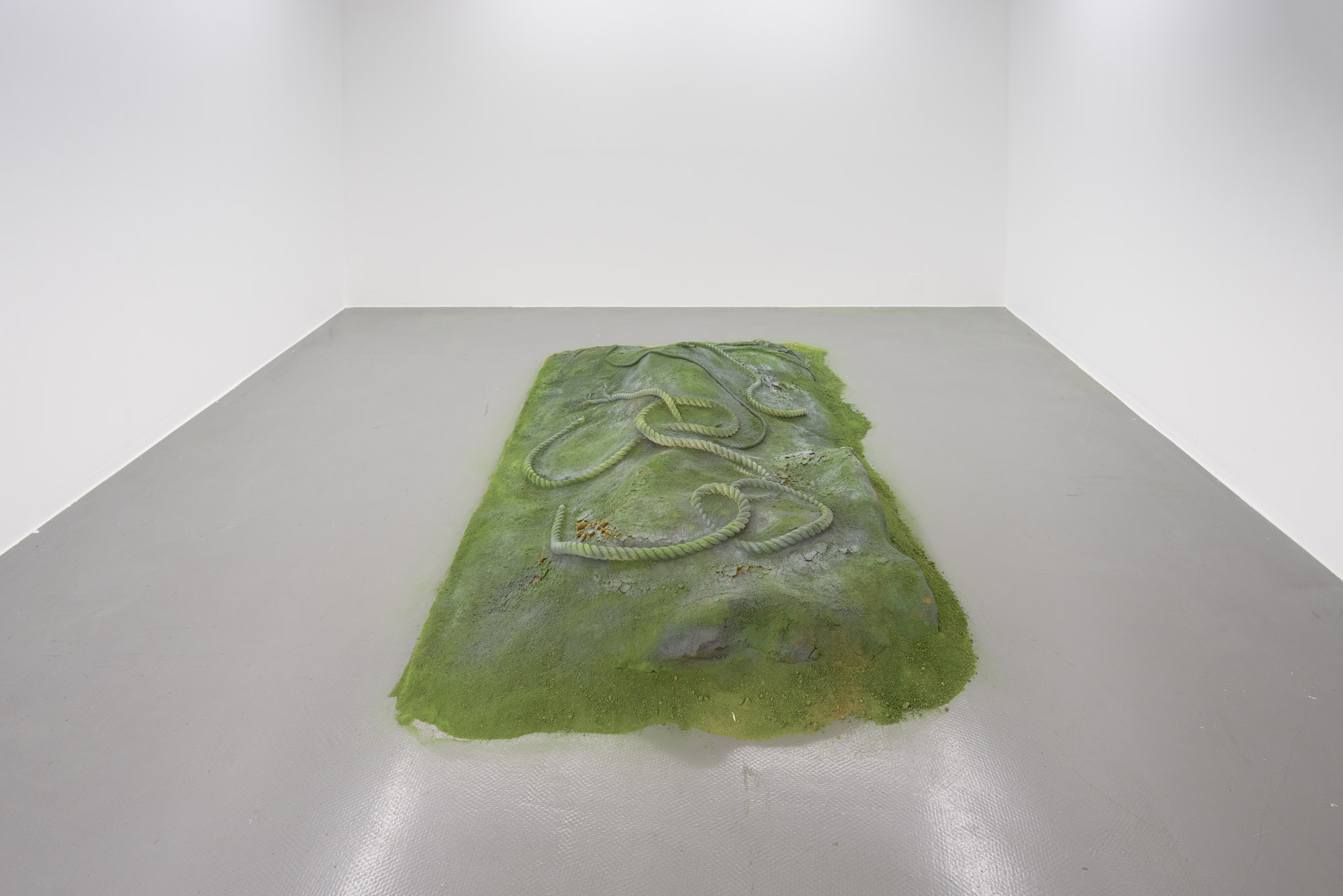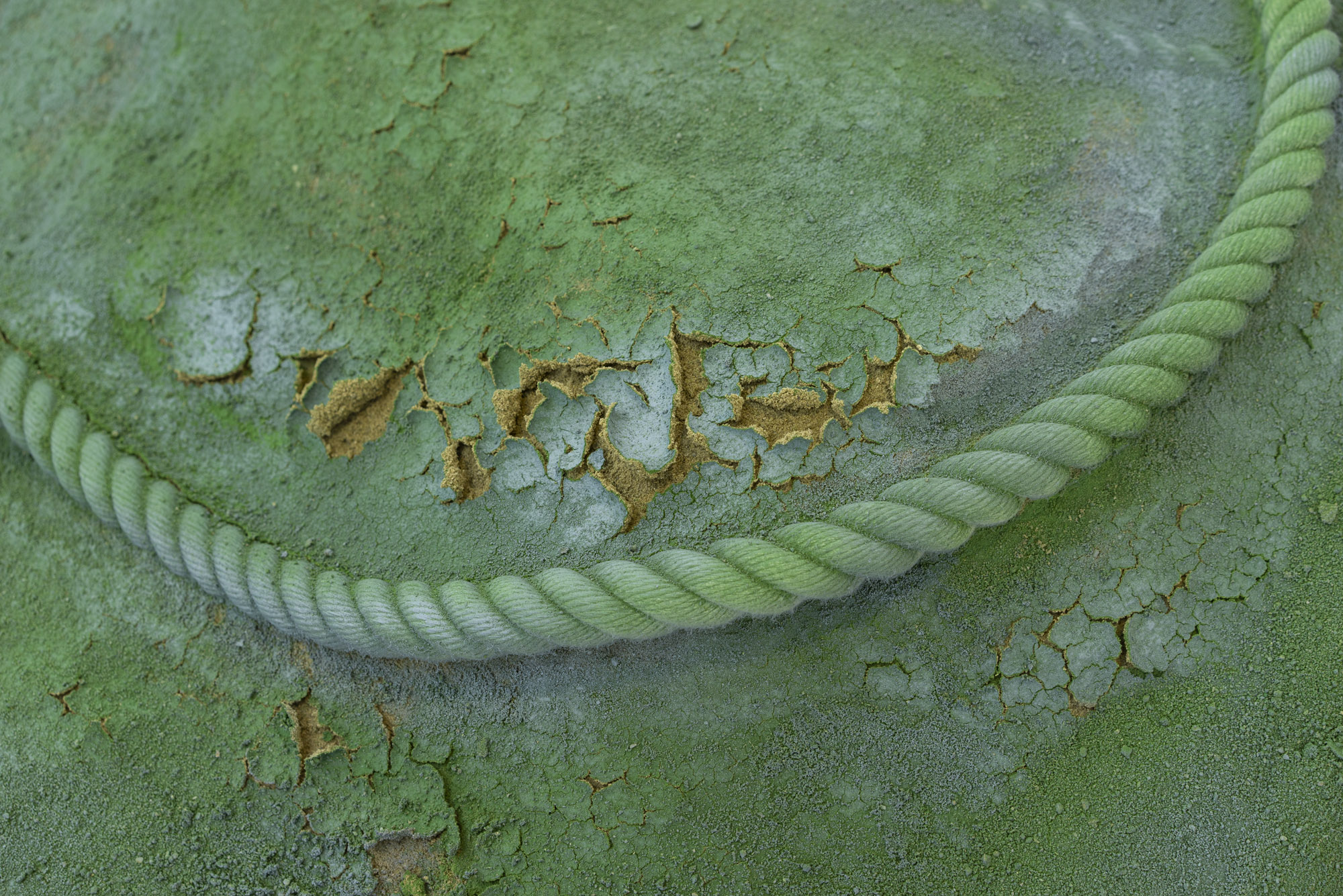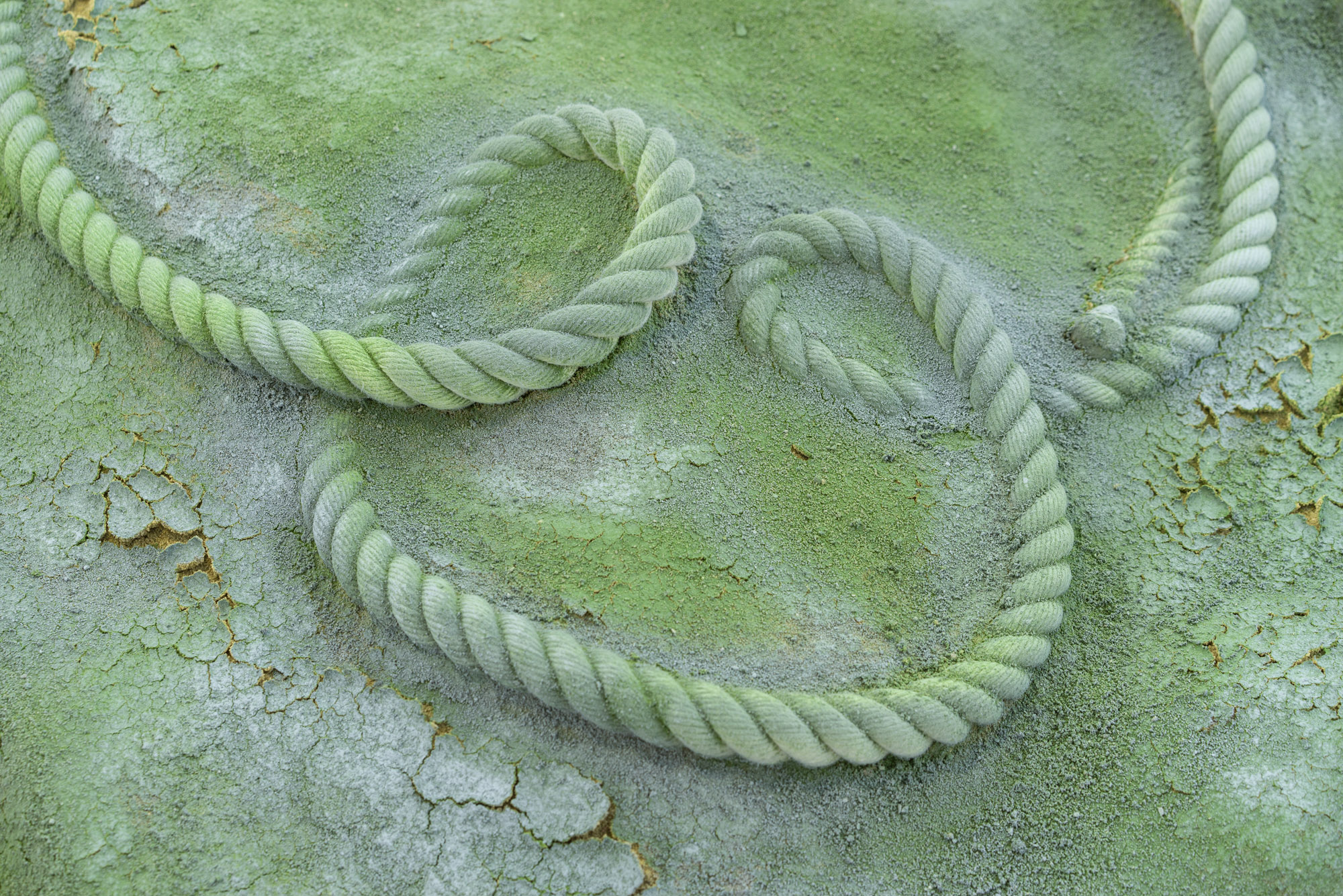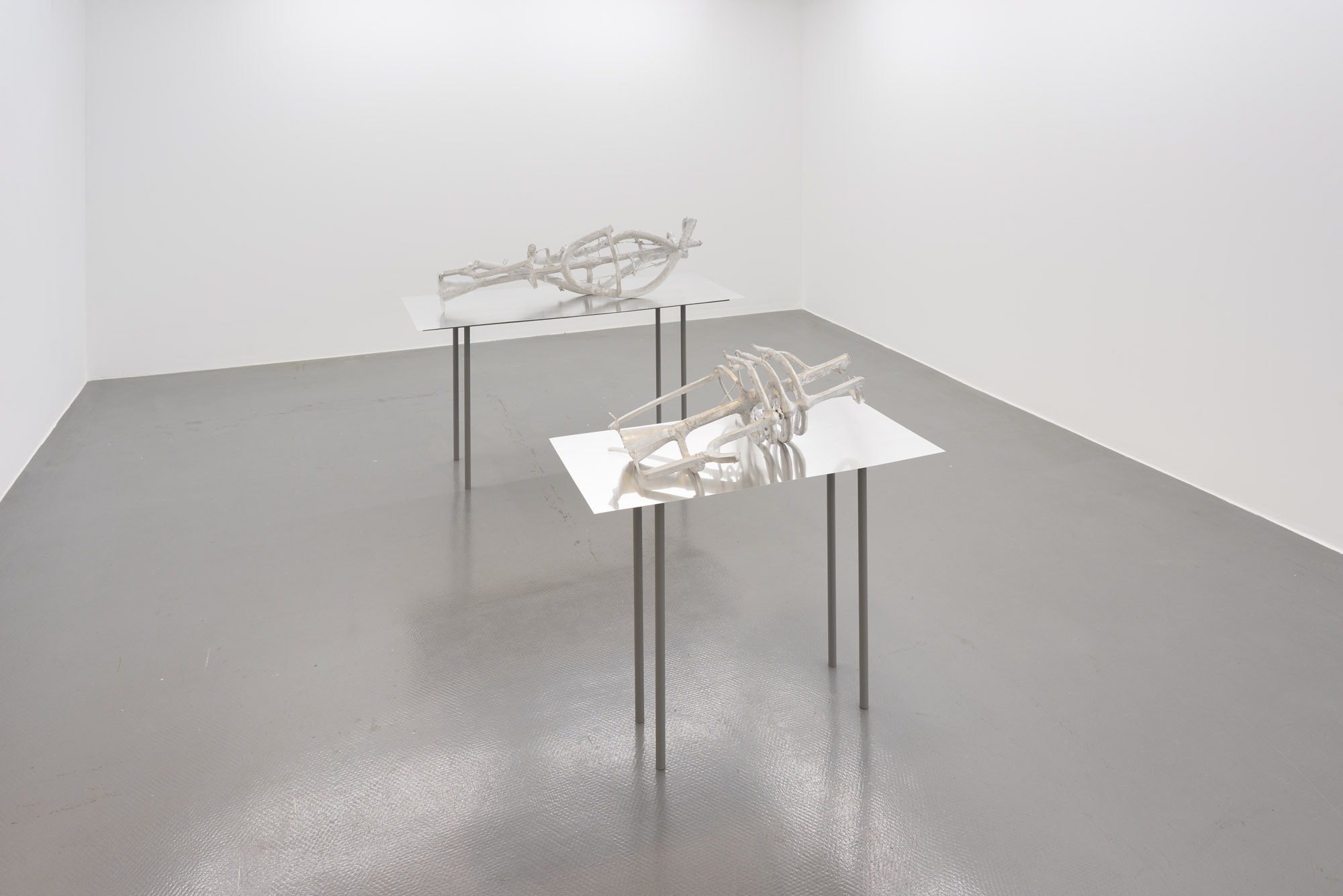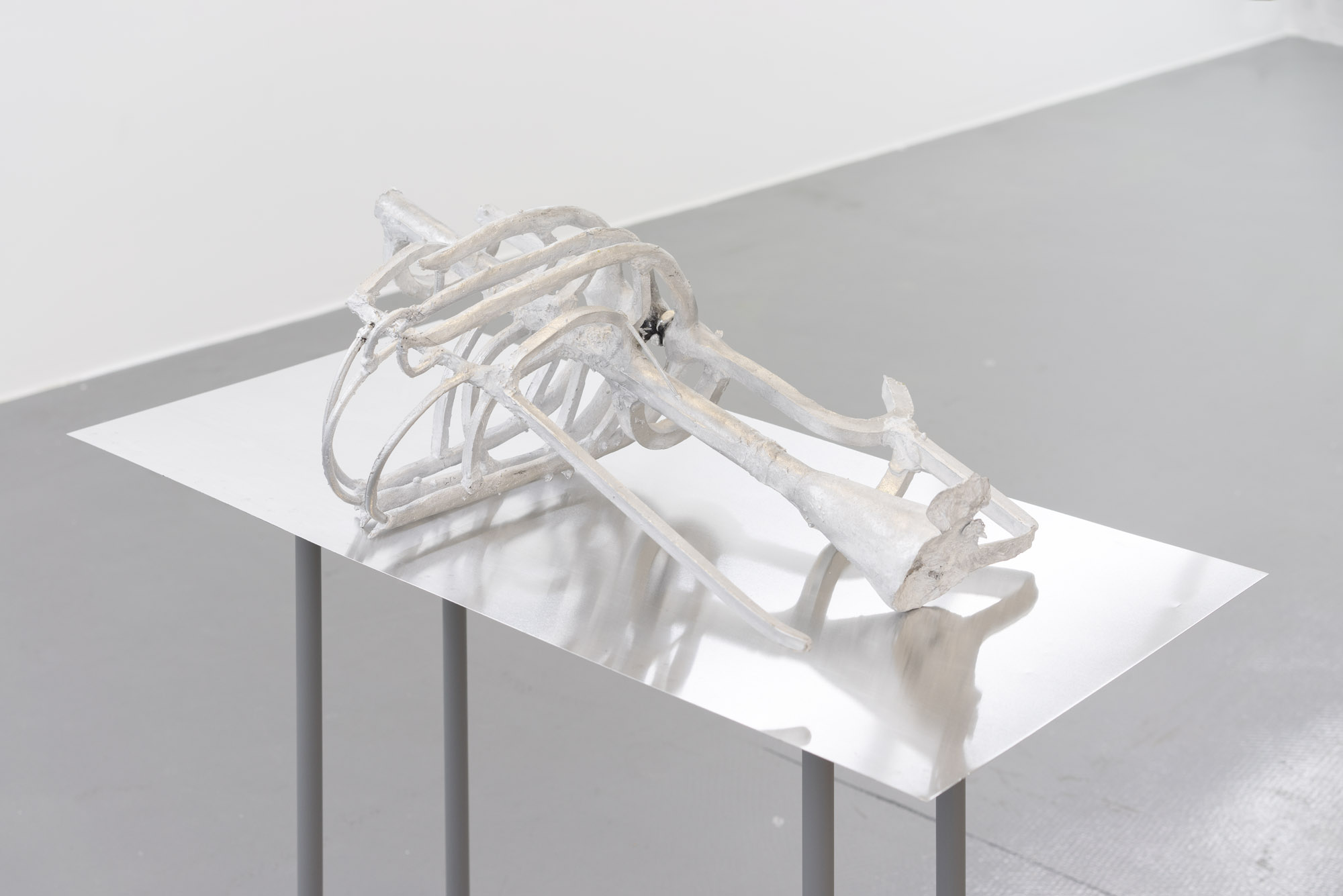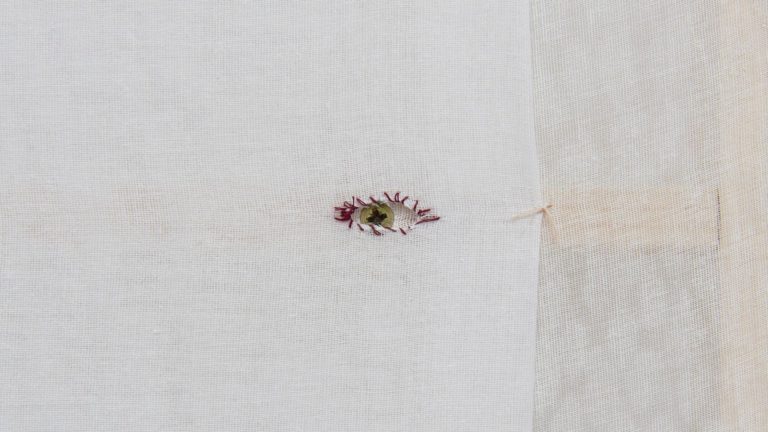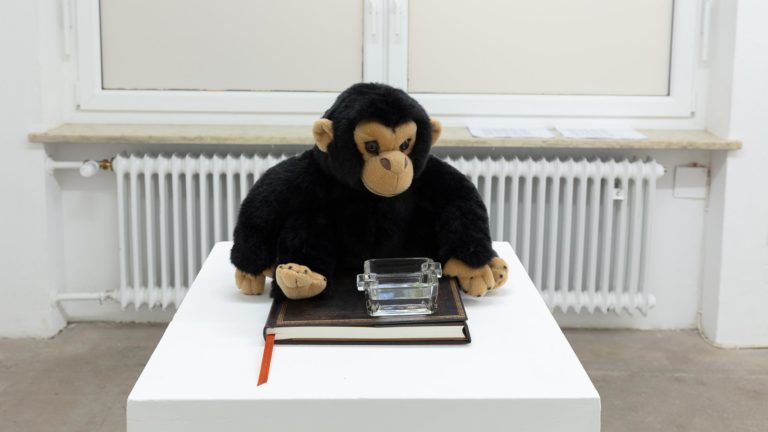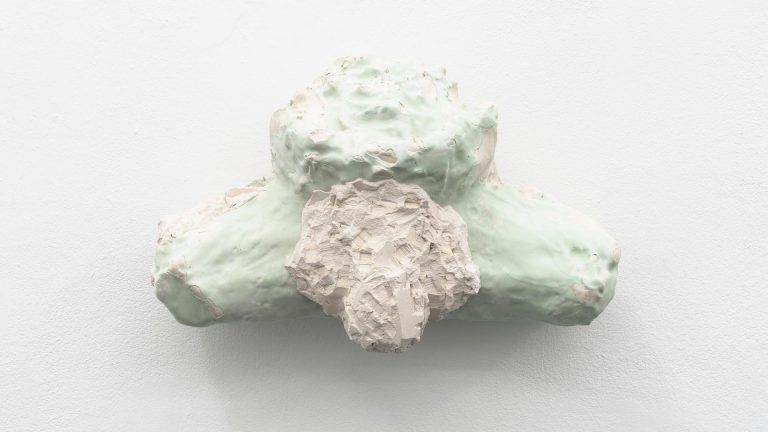Artist: Janina Frye
Exhibition title: Looping
Curated by: Hannah Eckstein
Venue: Kunstverein Friedrichshafen, Friedrichshafen, Germany
Date: September 24 – November 13, 2022
Photography: all images copyright and courtesy of the artist and Kunstverein Friedrichshafen
Tears, sweat, blood, and breath is floating through drains into an entangled network of loopings of thoughts, emotions, senses, tension and release generating bewildered realities. Phantoms and spirits those who transcend the material order live in this breath of thoughts, manifesting and erecting the skeletons of new physical worlds.
Janina Frye
In her conceptual approach, Janina Frye’s artistic practice equals that of a researcher who investigates the human body and the way it is connected to its environment. Thus, her sculptures and installations also represent a concept of the human being – a continuously transforming system which links the body through connections and interconnections to the outside world. She explores the idea that the human skin is not an impenetrable boundary but an interface to the outside world. She asks to what extent the modern binary logic between human and object, animate and inanimate, and between nature and culture is being upset in the 21st century. Furthermore, she explores how changing realities of life drive different processes of alienation in our body perception and how immaterial and imaginary entities, fictions, phantoms, and emergent processes influence this alienation.
She often uses her own body, namely psychological and physiological processes, as inspiration exploring how thoughts, sensations and emotional states manifest themselves physically. She translates her subjective sensory impressions as well as their physical effects into material conditions, thus manifesting the invisible and the intangible in her works. The decisive factor for this approach is the realisation that thoughts, ideas and emotions drive us humans to cultivate and shape the world, thus also determining what appearance reality finally takes on. This applies not only to the objects people create with their imagination and surround themselves with but also to their interpersonal, cultural, social, ecological, and political networks of relationships.
By using different materials and objects, removed from their original contexts and combined with each other, Janina Frye creates a network of circulating references and connections. Human beings and the complex systems in which everything is integrated are always at the centre of this network.
This is also the case with the three works Phantom feelings 3–5 (2022), in which different materials and techniques interact with each other as a system. Three larger-than-life rectangular objects are leaning against the wall. They are covered by a green-grey latex skin beneath which traces and imprints of ropes, tubes and bones are visible. The upright objects, which appear like abstracted bodies, are connected to vacuum pumps that emit droning sounds. In an alternating interval, they extract air from the sculptural bodies. The latex stretches and the underlying surface becomes a relief reminiscent of heavily overstretched skin with veins and bones. Once the bodies are slowly inflated again, the skin relaxes and the underlying relief visibly disappears. Janina Frye applies the movement of breathing to non-living material, questioning what it exactly means to be alive in a mechanised world. The combination of industrial materials gives rise to a system that only appears to be alive with its attributes of “being human”. However, it is merely an imitation which makes the human being present precisely through its absence.
Janina Frye’s works often remain in a kind of suspended state and play with the viewer’s perception. This is also the case with the two larger-than-life sculptures Volta (2022) and Remote (2022). Their bodies are created out of ropes that stretch upwards in graphical lines. At first glance, it is not clear how the ropes have acquired the ability to rise. Only on closer inspection it becomes apparent that they are made of solid material, namely aluminium, and thus defy gravity. Like mythical creatures or figures that have escaped from a superhero or science fiction movie, they look down upon us viewers and are ultimately a symbol of how fantasy and imagination manifest themselves in reality.
In addition to works created from everyday objects, Frye also uses traditional sculptural techniques. Both sculptures were made using a sand-casting process. Their bodies were first “drawn” into the sand with a rope in an intuitive act, simultaneously placing them in a state of suspension between two- and three-dimensionality. Only by pouring out the imprints they completely crossed the boundary to three-dimensionality and now face us as sculptures in space.
Janina Frye recreates these processes in a laboratory situation and makes them tangible and comprehensible. With the help of moulding sand and ropes, she has recreated the exact moment when the artistic idea and her own intuition first became form in the sand. As if in an experimental arrangement, there are two further aluminium sculptures on pedestals looking like dissecting tables. The sculptures appear like skeletons that have been disassembled into their individual parts. The casting channels that were needed to guide the aluminium into the moulds have not been removed. They give rise to another skeleton, which in turn forms a visual network and connects the individual components with each other. On the one hand, the installation makes the process of creating the aluminium sculptures comprehensible. On the other hand – and this is actually the focus of Janina Frye’s interest – they make visible the invisible process taking place when an artistic idea becomes reality.
Mist rises from the drainage channel in the entrance area, linking the whole exhibition through the elements of air and water. The mist illustrates how everything is connected to everything else and once again makes the invisible visible. Us viewers are repeatedly confronted with our own physicality and are given the opportunity to reflect on how we are connected to our environment, how we are influenced by it and how we influence it in turn. Always resonating in Frye’s works is the insight that the numerous systems and networks in which humans are integrated as well as their interactions are far too complex to decipher and understand their modes of action down to the last detail. As does the paradox that man, with their insatiable urge to understand the world and the nature of things has only made the reality in which he lives in more complex.
Accordingly, the rope runs like a thread through the whole exhibition right up to the titular Looping, as a utilitarian object which initially possesses the ambivalent abilities not only to connect but also to limit and exclude. The symbolism of the red thread also suggests that the rope stands for a coherent logic. But what actually happens, Janina Frye insists, “when this thread suddenly gets a lot of loops and knots and you end up with a completely different logic?”
Janina Frye was born in Neuwied in 1987, she lives and works in Amsterdam. In 2014 she received her Bachelor in Visual Art from AKV St. Joost ‘s-Hertogenbosch (NL) and in 2021 her Master in Sculpture from the Royal College of Art, London (UK). In 2017, Frye was awarded the Young Talent Award by the Mondriaan Fond. In 2020, she was a participant at the EKWC (European Ceramic Work Center) in the Netherlands. Her works have been shown in solo and group exhibitions at Arti et Amicitae, Amsterdam, First Site, Colchester, Old Operation Theatre Museum, London, Onomatopee, Eindhoven, P/////AKT, Amsterdam, the Stedelijk Museum, ‘s-Hertogenbosch, the Saatchi Gallery, London and at the South London Gallery, London.
Janina Frye, Looping, 2022, exhibition view, Kunstverein Friedrichshafen
Janina Frye, Looping, 2022, exhibition view, Kunstverein Friedrichshafen
Janina Frye, Volta, 2022, aluminum, steel, 5 parts, 220 x 150 x 150 cm
Janina Frye, Volta, 2022, aluminum, steel, 5 parts, 220 x 150 x 150 cm
Janina Frye, Remote, 2022, aluminum, steel, 4 parts, 180 x 150 x 150 cm, Phantom feelings 4, 2022, Vacuum pump, vacuum controller, ropes, bones, epoxy, rubber tape, cords, latex, 300 x 85 x 3 cm
Janina Frye, Remote, 2022, aluminum, steel, 4 parts, 180 x 150 x 150 cm
Janina Frye, Remote, 2022, aluminum, steel, 4 parts, 180 x 150 x 150 cm
Janina Frye, Remote, 2022, aluminum, steel, 4 parts, 180 x 150 x 150 cm
Janina Frye, Phantom feelings 5, 2022, Vacuum pump, vacuum controller, ropes, bones, epoxy, rubber tape, cords, latex, 300 x 85 x 3 cm
Janina Frye, Phantom feelings 5, 2022, Vacuum pump, vacuum controller, ropes, bones, epoxy, rubber tape, cords, latex, 300 x 85 x 3 cm
Janina Frye, Phantom feelings 3, 2022, Vacuum pump, vacuum controller, ropes, bones, epoxy, rubber tape, cords, latex, 300 x 85 x 3 cm
Janina Frye, Untitled, 2022, sand, bentonite, pigment, ropes, measures variable
Janina Frye, Untitled, 2022, sand, bentonite, pigment, ropes, measures variable
Janina Frye, Untitled, 2022, sand, bentonite, pigment, ropes, measures variable
Janina Frye, Looping, 2022, exhibition view, Kunstverein Friedrichshafen
Janina Frye, Carcass 2, 2022, aluminum, 60 x 43 x 20 cm
Janina Frye, Carcass 2, 2022, aluminum, 60 x 43 x 20 cm
Janina Frye, Carcass 1, 2022, aluminum, 103 x 30 x 35 cm
Janina Frye, Carcass 1, 2022, aluminum, 103 x 30 x 35 cm

